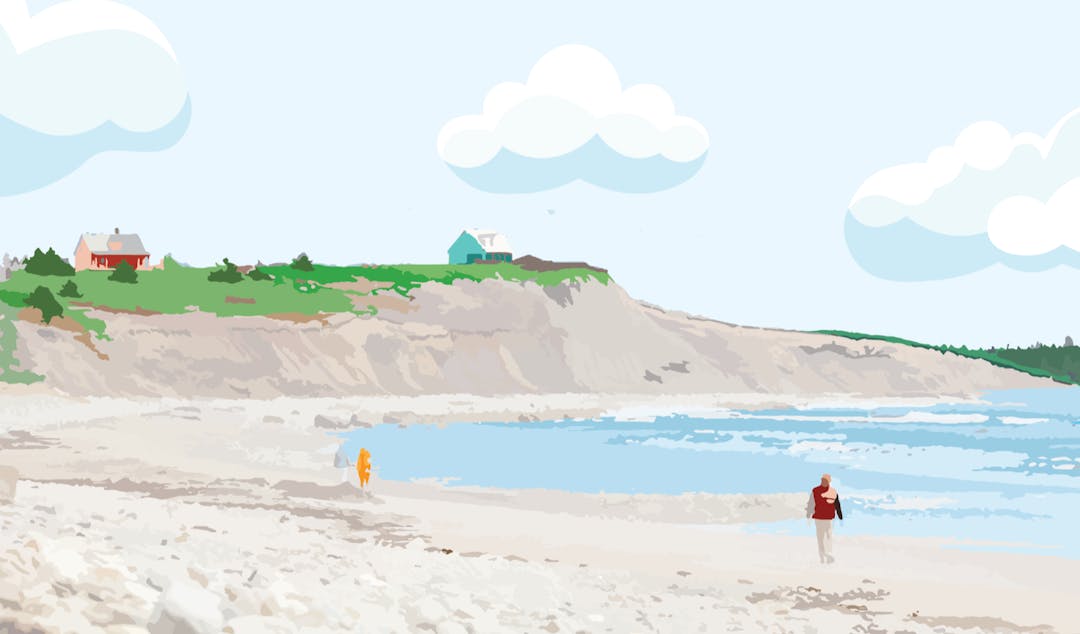Coastal Protection
Consultation has concluded

The Municipality of the District of Lunenburg (MODL) is developing new rules that will impact how development occurs along our coast. MODL has a responsibility to its residents and our environment to ensure that new homes, businesses, and other structures are not placed in areas that could be at risk of coastal flooding or erosion, while protecting our natural assets from potential harms caused by development. The new regulations are intended to meet two primary objectives:
- Protecting our communities from our coast: Keeping human activity away from the risks posed by coastal erosion and flooding.
- Protecting our coastline fromContinue reading
The Municipality of the District of Lunenburg (MODL) is developing new rules that will impact how development occurs along our coast. MODL has a responsibility to its residents and our environment to ensure that new homes, businesses, and other structures are not placed in areas that could be at risk of coastal flooding or erosion, while protecting our natural assets from potential harms caused by development. The new regulations are intended to meet two primary objectives:
- Protecting our communities from our coast: Keeping human activity away from the risks posed by coastal erosion and flooding.
- Protecting our coastline from us: Protecting our sensitive coastal ecosystems from the impacts of human activity and development.
Why is MODL doing this?
Regulations controlling where and how coastal development can occur in MODL are needed now. We are facing a climate emergency that is causing rising sea levels and an increase in extreme weather events. At the same time, development pressures and land values have resulted in unsustainable forms of development along our coast. In some cases, due to their size and location, substantial levels of rock armouring or other hardened shoreline treatments are required to protect these properties, potentially causing negative impacts on local ecosystems and public spaces.
Much of the unsustainable development currently occurring is being driven by a lack of existing regulations. Most coastal communities in MODL have no regulations on how close structures can be to the coastline or coastal wetlands, or how elevated above sea level new structures must be built. While the Province of Nova Scotia passed the Coastal Protection Act four years ago, regulations to implement this legislation have still not been introduced. In the absence of provincial action, MODL is moving forward to fill this gap.
What regulations are being proposed?
The Municipality is considering regulations to ensure that new development is not placed in areas that are at risk of coastal erosion, coastal flooding, or that would cause harm to sensitive ecosystems such as coastal wetlands or sand dunes. More specifically, regulations could introduce special requirements or limit new building in the following areas:
1. Areas at risk of coastal erosion
Regulations to protect structures such as houses from the risks of coastal erosion are typically in the form of horizontal setbacks from the water or edge of a cliff. The goal of the setback would be to ensure that new structures are located in areas that are safe and where they could remain in place for the lifespan of the structure (typically 70-100 years). There are different methods to establishing these horizontal setbacks that range from one-size-fits-all approaches to site-by-site evaluations. To learn more about coastal erosion click here. To help shape the regulations you would like to see please fill out our survey here.

2. Areas at risk of coastal flooding
Regulations to protect structures such as houses from the risks of coastal flooding are typically in two forms:
1. A vertical elevation requirement for new buildings, or
2. Limiting building within areas deemed to be at risk of coastal flooding.
The goal of these regulations would be to ensure that new structures are located in areas that are safe. It would also be intended to ensure those buildings could remain in place for the lifespan of the structure (typically 70-100 years), and to ensure human lives and emergency responders are not put at risk. There are different methods to establishing these regulations, but all of them take into account the impacts of sea level rise and storm surge. To learn more about how vertical elevations deal with coastal flooding click here. To help shape the regulations you would like to see please fill out our survey here.
 Example of a vertical elevation or setback related to coastal flooding.
Example of a vertical elevation or setback related to coastal flooding.3. Areas within or near sensitive coastal ecosystems
Regulations to protect sensitive coastal ecosystems such as coastal wetlands and dunes are typically in the form of conservation zones that limit development, and setbacks from the edge of these features to lessen the impact of nearby development. The goal of these regulations would be to help protect the integrity and function of these important natural assets and to preserve them into the future. To learn more about sensitive coastal ecosystems click here. To help shape the regulations you would like to see, please fill out our survey here.
 Example of a coastal wetland that is part of a sensitive coastal ecosystem.
Example of a coastal wetland that is part of a sensitive coastal ecosystem. Where will these regulations apply?
All properties directly bordering either the ocean or along the LaHave River (to the border with the Town of Bridgewater) are currently being considered within the project area. In addition, environmental features such as coastal wetlands or sand dunes that have a direct function which relates to the ocean are also being considered as part of the project area. However, the exact geography of where any new rules would apply has not yet been determined, as this partly depends on the type of regulatory approach used.
When will the regulations be approved?
The Municipality is looking to introduce these new regulations as soon as possible, while also ensuring that the process gives ample time and opportunity for public input and education. The current timeline aims to have the regulations approved by the end of 2023.
-
Coastal Protection What We Heard Report
Share Coastal Protection What We Heard Report on Facebook Share Coastal Protection What We Heard Report on Twitter Share Coastal Protection What We Heard Report on Linkedin Email Coastal Protection What We Heard Report linkYou can now read the Coastal Protection What We Heard Report (WWHR)! The Coastal Protection WWHR summarizes all the feedback that was collected through the various forms of public engagement on the topic of Coastal Protection. A special Council meeting that is open to the public will be held on August 29, 2023, from 9AM - 12PM where planning staff will present the WWHR findings.
To read the full report, go to https://engage.modl.ca/coastal-protection and scroll down to 'Background Documents' on the right side of your screen, then click 'Coastal Protection What We Heard Report 2023'.
The Municipality of the District of Lunenburg extends our gratitude to everyone who participated, your feedback is invaluable to the progression of this project.
-
Project Update
Share Project Update on Facebook Share Project Update on Twitter Share Project Update on Linkedin Email Project Update linkThank you everyone for your interest and participation in this initiative!
A What We Heard report is being prepared to summarize the input you've provided and it will be presented to Council at a special meeting on August 29th, at 9am which will be held at the municipal building at 10 Allée Champlain Drive, Cookville, NS. The report will also be posted to this site in the days leading up to the 29th. Workshops with Council will be held in September, with staff recommendations and draft regulations coming forward in the Fall. Further updates will be provided on upcoming public meetings in the coming months.
Background Documents
-
 2024-05-14 Municipal Planning Strategy (446 KB) (pdf)
2024-05-14 Municipal Planning Strategy (446 KB) (pdf)
-
 2024-05-14 Municipal-Wide Land Use Bylaw (291 KB) (pdf)
2024-05-14 Municipal-Wide Land Use Bylaw (291 KB) (pdf)
-
 2024-04-09 First Reading Report (205 KB) (pdf)
2024-04-09 First Reading Report (205 KB) (pdf)
-
 2024-04-09 Slides from Council Presentation.pdf (619 KB) (pdf)
2024-04-09 Slides from Council Presentation.pdf (619 KB) (pdf)
-
 Coastal Protection Open Houses - Carolyn's Speaking Notes (122 KB) (pdf)
Coastal Protection Open Houses - Carolyn's Speaking Notes (122 KB) (pdf)
-
 Staff Report - Coastal Protection (1.06 MB) (pdf)
Staff Report - Coastal Protection (1.06 MB) (pdf)
-
 Coastal Protection Open House Staff Presentation.pdf (11.7 MB) (pdf)
Coastal Protection Open House Staff Presentation.pdf (11.7 MB) (pdf)
-
 2024-01-09 Coastal Protection Regulation Options Report (1.43 MB) (pdf)
2024-01-09 Coastal Protection Regulation Options Report (1.43 MB) (pdf)
-
 PAC Coastal Protection Recommendations Report.pdf (449 KB) (pdf)
PAC Coastal Protection Recommendations Report.pdf (449 KB) (pdf)
-
 Coastal Protection What We Heard Report 2023 (15.5 MB) (pdf)
Coastal Protection What We Heard Report 2023 (15.5 MB) (pdf)
-
 Coastal Protection Summary One Pager (496 KB) (pdf)
Coastal Protection Summary One Pager (496 KB) (pdf)
Maps
-
 How to use the Interactive Map.pdf (371 KB) (pdf)
How to use the Interactive Map.pdf (371 KB) (pdf)
-
 Map 1 MODL Secondary Plan Areas (7.11 MB) (pdf)
Map 1 MODL Secondary Plan Areas (7.11 MB) (pdf)
-
 Map 2 Designated Coastal Protection Area (7.81 MB) (pdf)
Map 2 Designated Coastal Protection Area (7.81 MB) (pdf)
-
 Schedule A Designated Coastal Protection Area (2.37 MB) (pdf)
Schedule A Designated Coastal Protection Area (2.37 MB) (pdf)
-
 Schedule B Development Constraints Map (28.2 MB) (pdf)
Schedule B Development Constraints Map (28.2 MB) (pdf)
-
 Schedule C Flood Risk Area (4.48 MB) (pdf)
Schedule C Flood Risk Area (4.48 MB) (pdf)
-
 Map 3 Municipal-Wide Land Use (6.99 MB) (pdf)
Map 3 Municipal-Wide Land Use (6.99 MB) (pdf)
FAQs
- I live in a coastal area. What does this mean for me?
- Will the coastal development regulations apply to existing structures? (ex. I built my house in 2002, will the regulations apply?)
- How will you ensure compliance with the regulations?
- Do you have the capacity internally to handle the increase in demand for development permits?
- Will the coastal development regulations apply to freshwater shorelines (ex. Lakes, rivers, streams)?
- Why are sea walls or rock armouring less effective than a living shoreline?
- Why are coastal development regulations important?
- How will the coastal development regulations affect property values?
- Can the coastal development regulations impact my insurance coverage?
- What about boathouses, fish shacks and other uses that need access to the water?
- I live in an area with an existing Land Use By-law. Which rules will apply?
- Are the coastal regulations in effect currently?
- What if there are roads near me that are at risk for coastal flooding and erosion?
- Do I need a permit to install armour rock along my shoreline?
- What is the Coastal Erosion Area?
- What is the Coastal Flood Risk Area?
- What is the Vegetative Buffer?
- What are Sensitive Coastal Ecosystems?
- What counts as a vegetated buffer? How dense does it need to be?
- How did you determine the 3.97 m vertical elevation setback for the Coastal Flood Risk Area and why didn’t you just round up to 4 m?
- How do I know where to measure from to meet the erosion risk setback?
- Where did the data on coastal wetlands come from?
- What is the process for challenging a Designated Coastal Wetland?
- Are there opportunities to add wetlands to the Development Constraints Map?
- What proportion of the people you engaged with were coastal property owners?
- Other municipalities and the province have decided against going forward with their coastal regulations. Why is MODL doing it?
- Were the studies you reviewed to inform the regulations specific to Nova Scotia’s unique coastline?
Videos
-
Click here to play video Coastal Wetlands - Interview With Ducks Unlimited A short audio-only interview with Izzy Clarke, Conservation Program Specialist, about how the Municipality of the District of Lunenburg can use coastal wetlands to better protect the coast from flooding and sea level rise.
-
Click here to play video Coastal Flooding - Interview With Dr. Eric Rapaport A short audio-only interview with Dr. Eric Rapaport, Professor of the School of Planning at Dalhousie University, about how the Municipality of the District of Lunenburg can prepare for increased coastal flooding and inundation.
-
 Click here to play video
Virtual Open House Recording
Click here to play video
Virtual Open House Recording
Who's Listening
-
Phone 902-530-2802 Email planning@modl.ca -

Phone 902-530-2802 Email planning@modl.ca -

Phone 902-530-2802 Email planning@modl.ca
Approvals process timeline
-
Initial Community Engagement
Coastal Protection has finished this stageCommunity engagement to gather public input on the new policies and regulations.
-
Review and Report
Coastal Protection has finished this stageStaff will review all information and comments received during the engagement process and report back to Council in a What We Heard Report. This report will be presented at a public Council Meeting and posted on this website.
-
Public Information Meeting - Planning Advisory Committee
Coastal Protection has finished this stageA public information meeting is held by the Planning Advisory Committee to present and explain the proposed policies and regulations. The committee may pass a motion recommending the amendments go to Council for First Reading.
-
Drafting Regulations
Coastal Protection has finished this stageBased on the research and public and Council input received to date, MODL planning staff will draft new Municipal Planning policies and Land Use By-law regulations related to coastal development.
-
First Reading - Council
Coastal Protection has finished this stageCouncil conducts First Reading with the new Municipal Planning policies and Land Use By-law regulations related to coastal development.
-
Information Sessions on Draft Regulations
Coastal Protection has finished this stageThe proposed new Municipal Planning policies and Land Use By-law regulations related to coastal development will be presented at public information sessions.
-
Formal Public Hearing
Coastal Protection has finished this stageCouncil conducts a formal public hearing on the new Municipal Planning policies and Land Use By-law regulations related to coastal development.
-
Second Reading - Council
Coastal Protection has finished this stageCouncil conducts Second Reading on the new Municipal Planning policies and Land Use By-law regulations related to coastal development.
-
Amendments Sent to Province
Coastal Protection has finished this stageAmendments and documents are sent to the Province of Nova Scotia for formal Ministerial approval.
-
Formal Notice Published
Coastal Protection is currently at this stagePolicies and regulations are in effect as of the date of the notice being published on the Municipal website.


